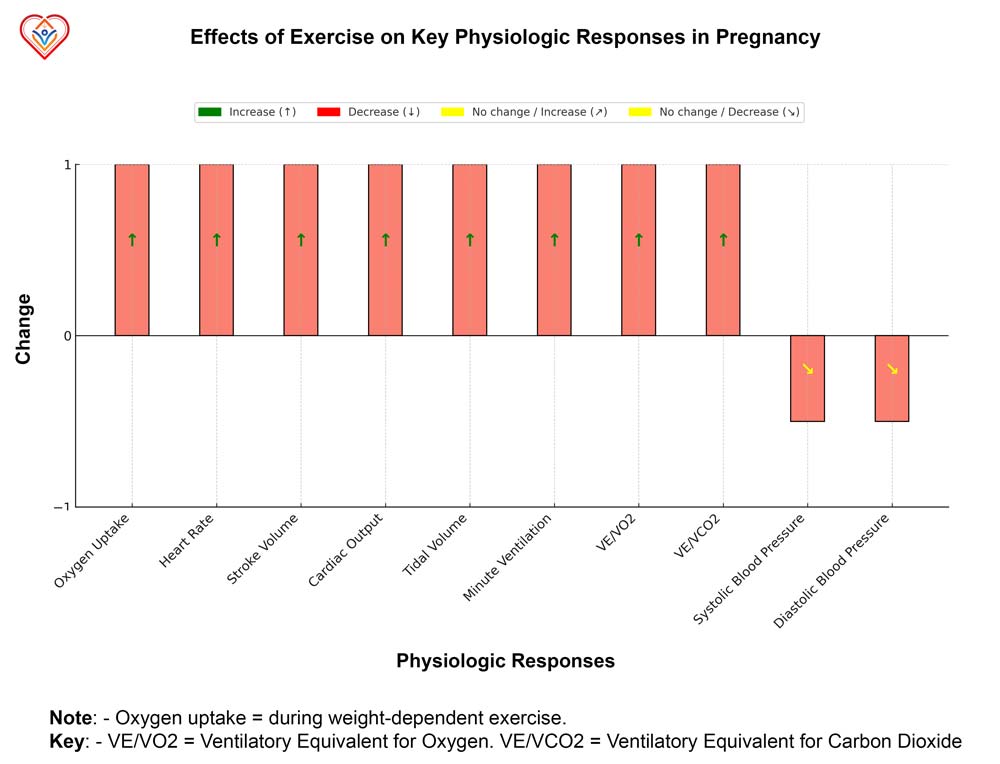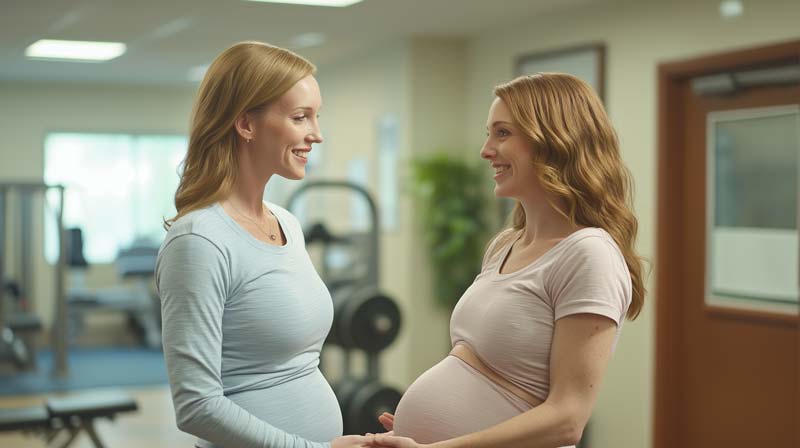By BeSund Editorial Team 11/07/2023 Modified Date: 17/010/2024
Pregnancy
Understand the importance of safe exercise during pregnancy
Pregnancy and Physical Activity

Understanding Pregnancy and Physical Activity
Pregnancy and physical activity share a crucial relationship that significantly impacts maternal and foetal health. As expectant mothers experience pregnancy, exercise becomes increasingly important. Regular physical activity during pregnancy offers numerous benefits, yet many women struggle to meet recommended guidelines.
Throughout gestation, a woman’s body undergoes remarkable physiological changes to accommodate the growing foetus. These adaptations influence exercise capacity and require a tailored approach to physical activity. From cardiovascular adjustments to alterations in energy metabolism, each trimester brings unique considerations for maintaining an active lifestyle.
Despite common misconceptions, engaging in appropriate physical activity during pregnancy is both safe and highly beneficial. Research indicates that regular exercise can help prevent complications such as gestational diabetes and preeclampsia while also promoting better birth outcomes. However, the type, intensity, and duration of exercise require careful consideration to ensure optimal results for both mother and child.
Defining Pregnancy and Physical Activity
Pregnancy and physical activity encompass a broad spectrum of bodily movements and structured exercise routines.
Physical activity during pregnancy refers to any skeletal muscle movement that results in energy expenditure above resting levels. This definition extends beyond traditional exercise to include daily activities and leisure pursuits.
Exercise, a subset of physical activity, involves planned, structured, and repetitive body movements aimed at improving physical fitness. For pregnant women, this may include activities such as walking, swimming, or prenatal yoga.
The World Health Organisation emphasises that physical activity during pregnancy should be tailored to individual needs and capabilities.
Physiological Adaptations in Pregnancy
Pregnancy induces significant physiological adaptations that directly impact exercise capacity. These changes include increased blood volume, elevated heart rate, and alterations in respiratory function. The growing uterus shifts the centre of gravity, affecting balance and posture.
Hormonal fluctuations lead to increased joint laxity, necessitating caution during specific exercises. Energy requirements also increase, with an additional 300 calories per day needed in the second and third trimesters. These adaptations highlight the importance of modifying exercise routines as pregnancy progresses.
Benefits of Physical Activity for Mother and Fetus
Engaging in regular physical activity during pregnancy yields numerous benefits for both mother and fetus. For expectant mothers, exercise can help manage weight gain, improve cardiovascular fitness, and enhance overall well-being. Studies have shown that physically active pregnant women experience reduced risk of gestational diabetes and hypertensive disorders.
The benefits extend to the developing fetus as well. Maternal exercise has been associated with improved placental function, potentially leading to better foetal growth and development. Some research suggests that babies born to active mothers may have improved cognitive function and a lower risk of childhood obesity.
The complicated relationship between pregnancy and physical activity provides valuable insights for expectant mothers considering their exercise routines. Looking at specific recommendations and precautions, it becomes clear that staying active during pregnancy contributes significantly to a healthy gestation.

The Impact of Pregnancy on Physical Performance
Pregnancy induces significant physiological and anatomical changes that affect a woman’s physical capabilities and endurance. These adaptations, while essential for foetal development, can present unique challenges when it comes to pregnancy and physical activity. Thus impacting the body’s ability to maintain physical activity throughout gestation.
As pregnancy progresses, women experience trimester-specific changes in their physical performance:
- First Trimester:
- Increased fatigue and nausea may affect exercise tolerance
- Minimal changes in body weight and centre of gravity
- Second Trimester:
- The growing uterus begins to shift the centre of mass
- Increased blood volume and heart rate impact cardiovascular function
- Third Trimester:
- Significant weight gain affects balance and coordination
- Reduced anaerobic working capacity
- Potential for joint instability due to hormonal changes
Despite these challenges, maintaining fitness during pregnancy offers numerous benefits, including:
- Better management of common pregnancy discomforts
- Improved mood and energy levels
- Potential for easier labour and delivery
- Enhanced postpartum recovery
Pregnancy and Physical Activity: Trimester-Specific Considerations
The impact of pregnancy on physical activity varies throughout gestation. In the first trimester, many women experience fatigue and nausea, which can affect their ability to engage in regular exercise.
As pregnancy progresses, the growing uterus and foetal weight can make certain activities more challenging, particularly in the third trimester. The following are some considerations for each trimester include:
First Trimester:
- Focus on maintaining pre-pregnancy fitness levels
- Be cautious of overheating during exercise
- Listen to your body and adjust the intensity as needed
Second Trimester:
- Modify exercises to accommodate a growing belly
- Avoid activities with a high risk of falling
- Incorporate pelvic floor exercises
Third Trimester:
- Emphasise low-impact activities
- Use supportive equipment, such as maternity belts
- Practice relaxation techniques in preparation for labour
Overcoming Challenges in Physical Performance During Pregnancy
Pregnant women face specific obstacles when engaging in physical activities. These challenges include:
- Changes in balance and coordination
- Increased risk of overheating
- Potential for joint instability
- Fatigue and reduced energy levels
To address these challenges, pregnant women can employ various strategies:
- Adapt exercise routines: Modify activities to accommodate changing physical capabilities and pregnancy and physical activity needs.
- Use proper equipment: Invest in supportive footwear and maternity workout gear.
- Stay hydrated: Increase fluid intake before, during, and after exercise.
- Listen to your body: Pay attention to warning signs and adjust intensity accordingly.
- Seek professional guidance: Consult with healthcare providers or prenatal fitness experts for personalised advice.
With a little adaptation to these challenges, women can maintain an active lifestyle throughout pregnancy, reaping the benefits of physical activity while ensuring the safety of both mother and foetus.

Pregnancy and Physical Activity as a Management Tool
Pregnancy and physical activity form a powerful partnership in managing maternal and foetal health.
Regular exercise during pregnancy offers countless benefits, serving as an effective tool for managing various pregnancy-related conditions and promoting overall well-being. Below are some highlights:
- Control gestational weight gain
- Reduce the risk of gestational diabetes
- Lower the likelihood of preeclampsia
- Alleviate common pregnancy discomforts
- Improve mood and reduce stress
- Enhance postpartum recovery
Research indicates that pregnancy and physical activity, when combined appropriately, can significantly impact birth outcomes. A study of over 2,800 pregnant women found that those engaging in regular physical activity were less likely to deliver babies with macrosomia (excessive birth weight) without increasing the risk of delivering small-for-gestational-age infants.
Pregnancy and physical activity can also play a crucial role in managing gestational diabetes. Women who participate in moderate-intensity exercise during pregnancy show improved glucose control and reduced insulin resistance. This management tool is particularly beneficial for women at higher risk of developing gestational diabetes.
Regular exercise during pregnancy has been associated with reduced symptoms of depression and anxiety. This makes physical activity a valuable management tool for maintaining emotional well-being throughout the gestational period.
Pregnancy and physical activity together can help manage the risk of preeclampsia. Studies have shown that women who engage in regular physical activity before and during pregnancy have a lower risk of developing this potentially dangerous condition. The protective effect is dose-dependent, with more active women experiencing more significant risk reduction.
To harness pregnancy and physical activity as an effective management tool, consider the following strategies:
- Start early: Begin a physical activity routine early in pregnancy or, ideally, before conception.
- Choose appropriate activities: Opt for low-impact exercises like walking, swimming, or prenatal yoga.
- Maintain consistency: Aim for regular physical activity sessions throughout the week.
- Listen to your body: Adjust intensity and duration based on how you feel.
- Stay hydrated: Drink plenty of water before, during, and after physical activity.
- Wear proper gear: Use supportive footwear and comfortable clothing.
Pregnancy and physical activity can work synergistically to manage common pregnancy discomforts. Regular exercise has been shown to reduce lower back pain, a frequent complaint among pregnant women.
Additionally, physical activity can help alleviate constipation and improve sleep quality, both common issues during pregnancy.
The management benefits of pregnancy and physical activity extend to labour and delivery. Women who maintain an active lifestyle during pregnancy often experience shorter labour durations and lower rates of interventional deliveries. This highlights the potential of physical activity as a tool for managing the childbirth process.
However, it’s crucial to consult with a professional before starting or continuing any exercise programs during pregnancy to ensure the safety of both mother and baby.
Recommended Exercises for Pregnant Women
Pregnancy and physical activity can work harmoniously to promote maternal and foetal health when approached with knowledge and care.
A well-structured exercise programme during pregnancy can help manage common discomforts, maintain fitness, and prepare the body for labour and delivery.
Safe Aerobic Exercises During Pregnancy
Aerobic exercises form the cornerstone of pregnancy and physical activity fitness routines. These activities help maintain cardiovascular health and manage weight gain. Safe options include:
- Walking: A low-impact activity suitable for all trimesters
- Swimming: Provides excellent cardiovascular benefits while supporting body weight
- Stationary cycling: Offers a stable, low-impact workout
- Low-impact aerobics: Helps maintain fitness without excessive joint stress
Aim to incorporate these activities into your routine at least three times per week, gradually building up to 150 minutes of moderate-intensity exercise.
Strength Training for Expectant Mothers
Resistance exercises can help maintain muscle tone and strength, which is beneficial during pregnancy and postpartum recovery. Consider these options:
- Body weight exercises: Squats, wall push-ups, and modified planks
- Light dumbbells: For upper body strength maintenance
- Resistance bands: Versatile tools for full-body workouts
Start with 1-2 sets of 10-15 repetitions for each exercise, focusing on proper form and breathing techniques.
Flexibility and Balance Exercises for Pregnancy Fitness
Maintaining flexibility and balance is crucial as your body changes during pregnancy. Consider incorporating:
- Prenatal yoga: Improves flexibility and promotes relaxation
- Stretching routines: Focus on major muscle groups, avoiding overstretching
- Modified Pilates: Enhances core strength and stability
Pregnancy and Physical Activity: FITT Recommendations
The FITT principle (Frequency, Intensity, Time, and Type) provides a framework for structuring safe and effective exercise programmes during pregnancy:
Frequency:
- Aim for at least 3-5 days per week
- Consistency is ideal for maintaining fitness and managing pregnancy symptoms
Intensity:
- Moderate intensity (able to talk while exercising)
- Use the Borg Rating of Perceived Exertion scale, aiming for 12-14 on a scale of 6-20
Time:
- 20-30 minutes per session for beginners
- Gradually increase to 30-60 minutes as fitness improves
- Accumulate 150 minutes of moderate-intensity activity per week
Type:
- Combine aerobic, strength, and flexibility exercises.
- Choose low-impact activities that minimise the risk of falls or abdominal trauma.
These recommendations should be tailored to individual fitness levels and pregnancy progression.

Adapting Exercises Throughout Pregnancy
As pregnancy progresses, it’s essential to modify exercises to accommodate physical changes:
First Trimester:
- Focus on establishing a routine
- Be mindful of fatigue and nausea
Second Trimester:
- Modify exercises to accommodate a growing belly
- Avoid exercises in the supine position after 16 weeks
Third Trimester:
- Emphasise pelvic floor exercises
- Reduce intensity and duration as needed
- Focus on activities that improve balance and prepare for labour
Always consult a healthcare professional before starting or continuing any exercise programme during pregnancy.
Safety Measures and Precautions for Pregnancy and Physical Activity
Engaging in physical activity during pregnancy offers numerous benefits, but it’s crucial to prioritise safety for both mother and baby. Proper precautions can ensure that pregnancy and physical activity coexist harmoniously.
Essential Safety Tips
- Stay well-hydrated before, during, and after exercise
- Avoid overheating, especially during the first trimester
- Wear supportive clothing and proper footwear
- Listen to your body and adjust the intensity as needed
- Avoid activities with a high risk of falls or abdominal trauma
Pregnancy and physical activity require constant awareness of your changing body. As your centre of gravity shifts, be mindful of balance-related issues and modify exercises accordingly.
Monitoring Maternal and Foetal Health
During pregnancy and physical activity sessions, it’s essential to be aware of warning signs that indicate the need to stop exercising:
- Vaginal bleeding or fluid leakage
- Persistent excessive shortness of breath
- Dizziness or headache
- Chest pain or heart palpitations
- Calf pain or swelling
- Uterine contractions or decreased foetal movement
If you experience any of these symptoms, cease physical activity immediately and consult your healthcare professional.
Adjusting Exercise Intensity
Pregnancy and physical activity guidelines recommend a gradual approach to exercise intensity:
- Previously sedentary women: Start with light-intensity exercise and progress slowly
- Women active before pregnancy: Generally safe to continue moderate-intensity exercise
- High-fitness level women: Vigorous exercise may be safe, but research is limited
The “talk test” helps gauge appropriate intensity during pregnancy and physical activity. You should be able to hold a conversation while exercising.
Consulting Healthcare Providers
Regular communication with healthcare professionals is crucial when combining pregnancy and physical activity. Seek professional advice:
- Before starting or continuing an exercise programme
- If you have any pre-existing medical conditions
- When experiencing unusual symptoms during or after exercise
- To discuss any concerns or questions about your exercise routine
Healthcare professionals can offer personalised advice based on your individual health status and pregnancy progression.
Adapting Exercise Throughout Pregnancy
As pregnancy advances, you may need to modify your approach to physical activity:
- First trimester: Focus on establishing a routine and managing fatigue
- Second trimester: Avoid exercises in the supine position after 16 weeks
- Third trimester: Reduce intensity and emphasise pelvic floor exercises
Understanding Contraindications
Certain conditions may contraindicate exercise during pregnancy. Absolute contraindications include:
- Ruptured membranes or premature labour
- Unexplained persistent vaginal bleeding
- Placenta previa after 28 weeks gestation
- Preeclampsia or pregnancy-induced hypertension
- Incompetent cervix or cerclage
- Multiple gestation at risk for premature labour
Consult your healthcare professional to discuss any potential contraindications specific to your pregnancy.
Living with Pregnancy: Fitness and Lifestyle Tips

Pregnancy and physical activity interlace daily habits and lifestyle choices, shaping expectant mothers’ overall health and well-being.
Research has shed light on various aspects of maintaining fitness and a healthy lifestyle during this transformative period.
Physical Activity Patterns
Studies indicate that accumulating 150-300 minutes of moderate-intensity exercise per week spread across most days, can contribute to a healthy pregnancy. This activity can encompass a wide range of movements, from structured exercise to daily tasks like housework and caregiving.
Interestingly, physical activity patterns often change throughout pregnancy. Some women experience a decrease in activity levels, particularly in late pregnancy, as their bodies adapt to the growing foetus.
Nutritional Considerations
Pregnancy and physical activity necessitate attention to nutritional needs. A balanced diet rich in fruits, vegetables, whole grains, lean proteins, and healthy fats complements an active lifestyle during pregnancy. Proper hydration becomes especially crucial when engaging in physical activities.
Research suggests that caloric needs increase only modestly during pregnancy. The focus, therefore, often shifts to nutrient-dense foods rather than simply increasing calorie intake.
Stress Management and Mental Well-being
The relationship between pregnancy and physical activity extends to mental health benefits. Regular exercise during pregnancy has been associated with reduced anxiety and depressive symptoms in several studies.
Promising stress management techniques include prenatal yoga, meditation, and deep breathing exercises. These practices and physical activity may contribute to overall emotional well-being during pregnancy.
Long-term Perspectives
Research indicates that maintaining fitness throughout pregnancy can lead to better postpartum outcomes. Studies have shown associations between prenatal exercise and reduced postpartum weight retention.
The benefits of an active pregnancy may extend to labour and delivery. Some research suggests a link between higher physical activity levels during pregnancy and shorter active labour duration.
Individualised Approaches
Every pregnancy is unique, and what works for one woman may not be suitable for another. Regular check-ups with healthcare professionals help ensure that exercise and lifestyle habits align with individual circumstances.
Women’s beliefs, values, and social support systems play significant roles in maintaining healthy behaviours during pregnancy. Those who understand and value the potential benefits of physical activity and nutrition are often more likely to engage in these behaviours.
Postpartum Considerations
The habits formed during pregnancy can influence postpartum recovery and long-term health. While some women may resume pre-pregnancy routines relatively quickly, others may need a more gradual approach.
Pelvic floor exercises, which can begin during pregnancy and continue postpartum, have shown potential benefits for recovery and long-term pelvic health.
When approached thoughtfully and in consultation with healthcare providers, pregnancy and physical activity can coexist to support maternal health and foetal development and potentially ease the transition to postpartum life.
Sources
- Aune D, Sen A, Henriksen TT, Saugstad OD, Tonstad S. Physical activity and the risk of gestational diabetes mellitus: a systematic review and dose-response meta-analysis of epidemiological studies. Eur J Epidemiol 2016;31:967–97.
- Aune D, Saugstad OD, Henriksen T, et al. Physical activity and the risk of preeclampsia: a systematic review and meta-analysis. Epidemiology. 2014;25:331-343.
- Barakat R, Pelaez M, Lopez C, et al. Exercise during pregnancy and gestational diabetes-related adverse effects: a randomised controlled trial. Br J Sports Med. 2013;47:630-636.
- Bisson M, Croteau J, Guinhouya BC, et al. Physical activity during pregnancy and infant’s birth weight: Results from the 3D Birth Cohort. BMJ Open Sport Exerc Med. 2017;3:e000242.
- Bø K, Artal R, Barakat R, et al. Exercise and pregnancy in recreational and elite athletes: 2016/2017 evidence summary from the IOC expert group meeting, Lausanne. Part 5. Recommendations for health professionals and active women. Br J Sports Med. 2018;52:1080-1085.
- Cannella D, Lobel M, Monheit A. Knowing is believing: Information and attitudes towards physical activity during pregnancy. J Psychosom Obstet Gynaecol. 2010;31(4):236-242.
- Clapp JF. Influence of endurance exercise and diet on human placental development and fetal growth. Placenta. 2006;27:527-534.
- Clapp JF 3rd, Lopez B, Harcar-Sevcik R. Neonatal behavioural profile of the offspring of women who continued to exercise regularly throughout pregnancy. Am J Obstet Gynecol. 1999 Jan;180(1 Pt 1):91-4.
- Davenport, MH, Ruchat, SM, Poitras, VJ, Jaramillo Garcia, A, Gray, CE, Barrowman, N, et al.. Prenatal exercise for the prevention of gestational diabetes mellitus and hypertensive disorders of pregnancy: a systematic review and meta-analysis. Br J Sports Med 2018;52:1367–75.
- Davenport MH, McCurdy AP, Mottola MF, et al. Impact of prenatal exercise on both prenatal and postnatal anxiety and depressive symptoms: a systematic review and meta-analysis. Br J Sports Med. 2018;52:1376-1385.
- Entin PL, Munhall KM. Recommendations regarding exercise during pregnancy made by private/small group practice obstetricians in the USA. J Sports Sci Med. 2006;5:449-458.
- Evenson KR, Barakat R, Brown WJ, et al. Guidelines for physical activity during pregnancy: comparisons from around the world. Am J Lifestyle Med. 2014;8(2):102-121.
- Evenson KR, Mottola MF, Owe KM, et al. Summary of international guidelines for physical activity following pregnancy. Obstet Gynecol Survey. 2014;69(7):407-414.
- Gaston A, Cramp A. Exercise during pregnancy: a review of patterns and determinants. Journal of Science and Medicine in Sport. 2011;14(4):299-305. doi:10.1016/j.jsams.2011.02.006.
- Huberty JL, Buman MP, Leiferman JA, et al. Trajectories of objectively-measured physical activity and sedentary time over the course of pregnancy in women self-identified as inactive. Prev Med Rep. 2016;3:353-360.
- Institute of Medicine (US) and National Research Council (US) Committee to Reexamine IOM Pregnancy Weight Guidelines. Weight Gain During Pregnancy: Reexamining the Guidelines. Rasmussen KM, Yaktine AL, editors. Washington (DC): National Academies Press (US); 2009.
- Mottola MF, Davenport MH, Ruchat SM, et al. 2019 Canadian guideline for physical activity throughout pregnancy. Br J Sports Med. 2018;52:1339-1346.
- Nascimento SL, Surita FG, Cecatti JG. Physical exercise during pregnancy: a systematic review. Current Opinion in Obstetrics and Gynecology. 2012;24(6):387-394.
- Negrato CA, Montenegro RM Jr, Mattar R, et al. Dysglycemias in pregnancy: from diagnosis to treatment. Brazilian consensus statement. Diabetol Metab Syndr. 2010;2:27.
- O’Connor PJ, Poudevigne MS, Cress ME, Motl RW, Clapp JF 3rd. Safety and efficacy of supervised strength training adopted in pregnancy. J Phys Act Health. 2011;8:309-320.
- Olson D, Sikka RS, Hayman J, Novak M, Stavig C. Exercise in pregnancy. Curr Sports Med Rep. 2009;8:147-153.
- Pescatello L S, Arena R, Riebe D, Thompson P D. Philadelphia: Lippincott Williams & Wilkins; 2014. ACSM’s guidelines for exercise testing and prescription. 9th ed.
- Physical Activity and Exercise During Pregnancy and the Postpartum Period: ACOG Committee Opinion, Number 804. Obstet Gynecol. 2020 Apr;135(4):e178-e188.
- Polis RL, Gussman D, Kuo YH. Yoga in pregnancy: An examination of maternal and fetal responses to 26 yoga postures. Obstet Gynecol. 2015;126:1237-1241.
- Poyatos-León R, García-Hermoso A, Sanabria-Martínez G, et al. Effects of exercise during pregnancy on mode of delivery: a meta-analysis. Acta Obstet Gynecol Scand. 2015;94:1039-1047.
- Ruchat SM, Mottola MF, Skow RJ, et al. Effectiveness of exercise interventions in the prevention of excessive gestational weight gain and postpartum weight retention: a systematic review and meta-analysis. Br J Sports Med. 2018;52:1347-1356.
- Schmidt MD, Freedson PS, Pekow P, et al. Validation of the Kaiser Physical Activity Survey in pregnant women. Med Sci Sports Exerc. 2006;38:42-50.
- Watkins VY, O’Donnell CM, Perez M, et al. The impact of physical activity during pregnancy on labor and delivery. Am J Obstet Gynecol. 2021;225(4):437.e1-437.e8.
- Watson ED, Norris SA, Draper CE, et al. “Just because you’re pregnant, doesn’t mean you’re sick!” A qualitative study of beliefs regarding physical activity in black South African women. BMC Pregnancy Childbirth. 2016;16:174.
- WHO Guidelines Approved by the Guidelines Review Committee. Global Recommendations on Physical Activity for Health. Geneva: World Health Organization. World Health Organization 2010.
- Wolfe, LA, Weissgerber, TL. Clinical physiology of exercise in pregnancy: a literature review. J Obstet Gynaecol Can 2003;25:473–83.
- Woodley SJ, Boyle R, Cody JD, et al. Pelvic floor muscle training for prevention and treatment of urinary and faecal incontinence in antenatal and postnatal women. Cochrane Database Syst Rev. 2017;12:CD007471.


